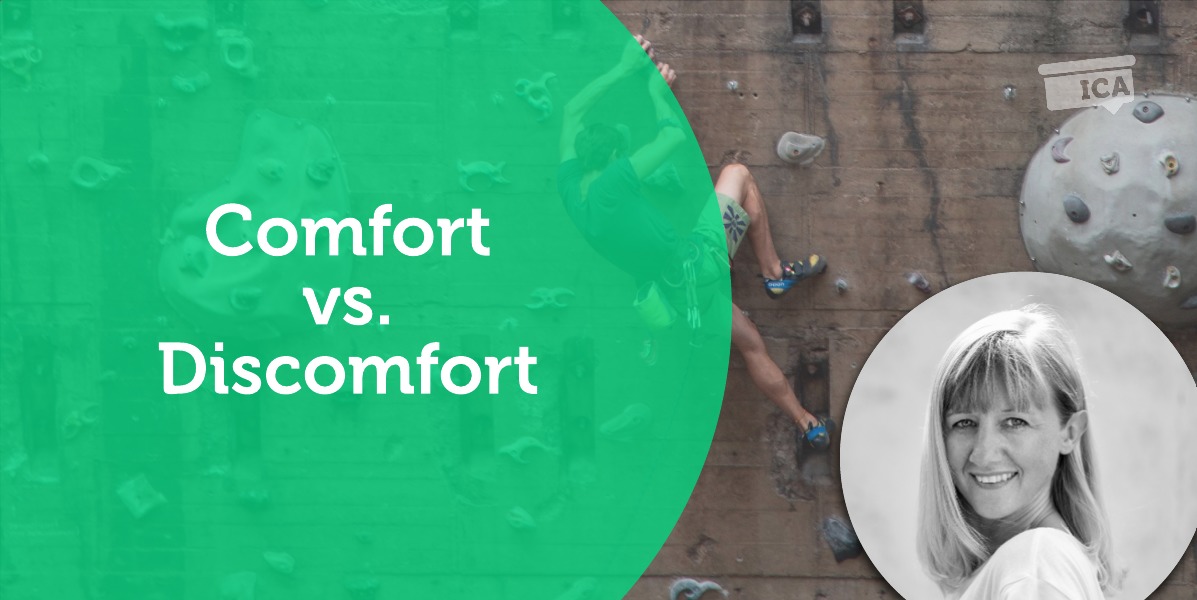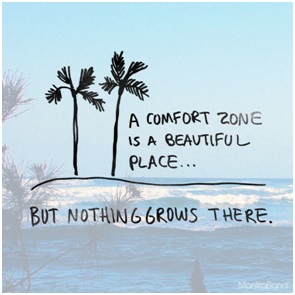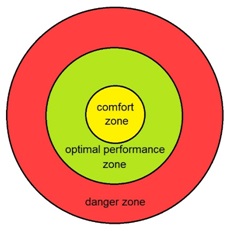
A Coaching Power Tool Created by Victoria Tanner
(Expat Women, UNITED KINGDOM)
Does your comfort zone make you uncomfortable?
Life will only Change when you become more committed to your dreams than you are to your comfort zone – Billy Cox
Definitions:
Comfort – Contented well-being; a life of ease and comfort.
Discomfort – To make uncomfortable or uneasy.
I recently took my children to an indoor climbing wall facility. My 8-year-old daughter was first to jump on the wall and start climbing. She didn’t quite reach the top, but she went very high and loved every minute. Then her best friend did the same, but she got all the way to the top, climbed over and stood, looking down on us all, proud and smiling.
My daughter slowly made her way down but stopped halfway, frozen with fear, crying and shaking. I was able to reach her and slowly coax her down, but she was terrified and sat with me crying for a long time, explaining that all she wanted to do was climb over the top, but was too scared.
Did I wonder how committed she really was to reach the top? She was certainly committed to being very careful, and she was definitely committed to looking after herself and staying safe (from my point of view, the best decision there is!). For her though, that wasn’t enough, she wanted to climb over the top. Knowing she was more than capable of doing it if she could only get over her fear, was a feeling she couldn’t manage, and it would only go away if she came out of her comfort zone and pushed herself just that little bit further, in order to reach her goal. She had to trust her strength and ability, rather than her fear of what MIGHT happen.
It took a few more goes, but she did it in the end and her great big smile and leap for joy at the top said it all. It was worth it! I did it!
Sometimes the decision to go for it is even harder than the task itself, but usually because we just haven’t found a way to approach the problem yet. Somewhere along the line, there’s a conflict and we need to find out where that is before we can address moving forward. The decision is the hardest part. Trying to work out what’s important to us, what we want the final outcome to be, what’s holding us back? With so many conflicting messages, it’s no wonder coming out of our comfort zone and moving forward is so difficult.
What if we really consider that which we want the most? To live in another country, to jump out of a plane, to start a small business, to lose a few pounds, to surf the biggest wave, to sleep a whole night through without being disturbed by one of the children, to learn a new language… Instead of thinking it’s not even plausible, start believing it’s actually possible, but only if we’re truly committed. Following through on a commitment gives us the power to change. We have to trust our strength and ability (mental and physical), rather than our fear of what MIGHT happen. We have to come out of our comfort zone.
How comfortable is that comfort zone after all? Perhaps not so much if we want to step out of it. Will it be easy? No. Will it be worth it? Definitely.
During a coaching session, a client introduces an issue they want to discuss. For some reason, they’re uncomfortable with it. Perhaps they don’t know how to address it, something is holding them back or they just need to voice their thoughts and concerns in order to make sense of it all. We all want to live a comfortable life and the coaching session gives the client a chance to determine not only what they are or are not comfortable with, but also what they are or are not comfortable discussing.
There are often underlying beliefs or concerns holding us back, and which are the real issue in our perceived problem. Will the client decide to reach a comfortable solution or will they go deeper, decide to address the discomfort and take a different approach to find and reach their desired outcome?
Either way, what always comes to my mind is the title to Marie Forleo’s latest book “Everything is Figureoutable”. Regardless of what the client decides to discuss in their session, it’s always figureoutable, on THEIR terms. The comfortable route may be the right one for them to take right now, but if they decide to try and address the discomfort, broken down into achievable steps, a comfortable solution can always be found.
The shift comes when the client can truly see where the discomfort lies and how they’re going to address it.
How does addressing the discomfort create a shift in perspective?

Here are a few ways to answer that question. By addressing discomfort, the client:
- may discover what is truly holding them back and empower themselves to address the real problem;
- may uncover a limiting belief from their past;
- may realise they are catastrophizing and things aren’t as bad as they seem;
- may see more clearly how they can move forward in small, achievable steps.
If a client does not, at some point, address the discomfort, they will continually come up against it and always find it hard to leave their comfort zone.
Example
|
Initial Problem Area |
Realisation |
Reframed Perspective |
|
I’ll never find my ideal home |
Family is really important to me and I’m looking for somewhere to raise a family |
I hadn’t realized how important raising a family was to me. It’s something I need to address, but for now, it’s not the right time, so a smaller place will do until I’m ready for something bigger |
|
I can’t lose weight |
I’m eating for comfort because I’m lonely |
I need to socialize more, perhaps join a few social groups and meet new people. |
|
My job is awful and I’m dreading a meeting with my boss. |
Catastrophising |
I just need to plan the purpose of the meeting a little better – decide what outcome I’m trying to achieve and how I want to approach my boss about it. |
|
I don’t know how to market my new business |
I’m afraid of social media and what people will think |
Do a social media online course, write some content, start small on just 1 platform rather than all of them. |
Coaching Application
A comfort zone is a psychological state in which things feel familiar to a person, and they are at ease, and in control of their environment, experiencing low levels of anxiety and stress. In this zone, a steady level of performance is possible.[1]
However, it’s very important to note that if we leave our comfort zone too quickly or at too fast a pace, it can actually be very detrimental. It’s therefore imperative that we support our clients moving forward at a rate that’s ideal for THEM, at any particular time, on any given day.
It’s also important that our clients feel completely at ease and comfortable in the coaching relationship. If a good relationship has not first been formed, it is unlikely the client will feel comfortable addressing uncomfortable issues!
Furthermore, apart from providing a safe space for clients to explore their worries and have a non-judgmental partner to discuss them with, it has recently been proven[2] that uncertainty (that area just outside our comfort zone) also signals the brain to kickstart learning. This means, that if a client can feel supported enough to very slowly and gently move away from their comfort zone, they are in the optimal place to improve their performance and ultimately have more chance of reaching their goals.

Think of it this way, as soon as you’ve discovered the best way to behave in any given environment, learning new techniques or approaches seems pointless. However, when we’re slightly challenged and trying to fit in, that’s when we’re in our ‘Optimal Anxiety’[3] space (or ‘Optimal Performance Zone’) and can maximise our performance.
Conclusion
In conclusion, supporting our clients to discover what is actually causing the discomfort can only be a good thing. How they decide to address it is up to them. It may lead them out of their comfort zone for a short time, but that’s the best place to grow.
Resources:
[1]https://psychcentral.com/blog/comfort-zones-an-alternative-perspective/
[2]https://news.yale.edu/2018/07/19/arent-sure-brain-primed-learning
[3]https://www.linkedin.com/pulse/optimal-anxiety-james-kelloway/